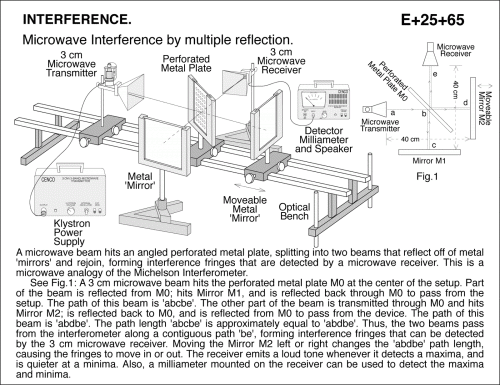Microwave interference by multiple reflection.
Primary tabs
Microwave Interference by multiple reflection. A microwave beam hits an angled perforated metal plate, splitting into two beams that reflect off of metal 'mirrors' and rejoin, forming interference fringes that are detected by a microwave receiver. This is a microwave analogy of the Michelson Interferometer. See Fig.1: A 3 cm microwave beam hits the perforated metal plate M0 at the center of the setup. Part of the beam is reflected from M0; hits Mirror M1, and is reflected back through M0 to pass from the setup. The path of this beam is 'abcbe'. The other part of the beam is transmitted through M0 and hits Mirror M2; is reflected back to M0, and is reflected from M0 to pass from the device. The path of this beam is 'abdbe'. The path length 'abcbe' is approximately equal to 'abdbe'. Thus, the two beams pass from the interferometer along a contiguous path 'be', forming interference fringes that can be detected by the 3 cm microwave receiver. Moving the Mirror M2 left or right changes the 'abdbe' path length, causing the fringes to move in or out. The receiver emits a loud tone whenever it detects a maxima, and is quieter at a minima. Also, a milliameter mounted on the receiver can be used to detect the maxima and minima.
UCB Index:
E+25+65
PIRA Index:
6D40.20
UCB Taxonomy:
PIRA Taxonomy:
Popularity:
- Log in to post comments

